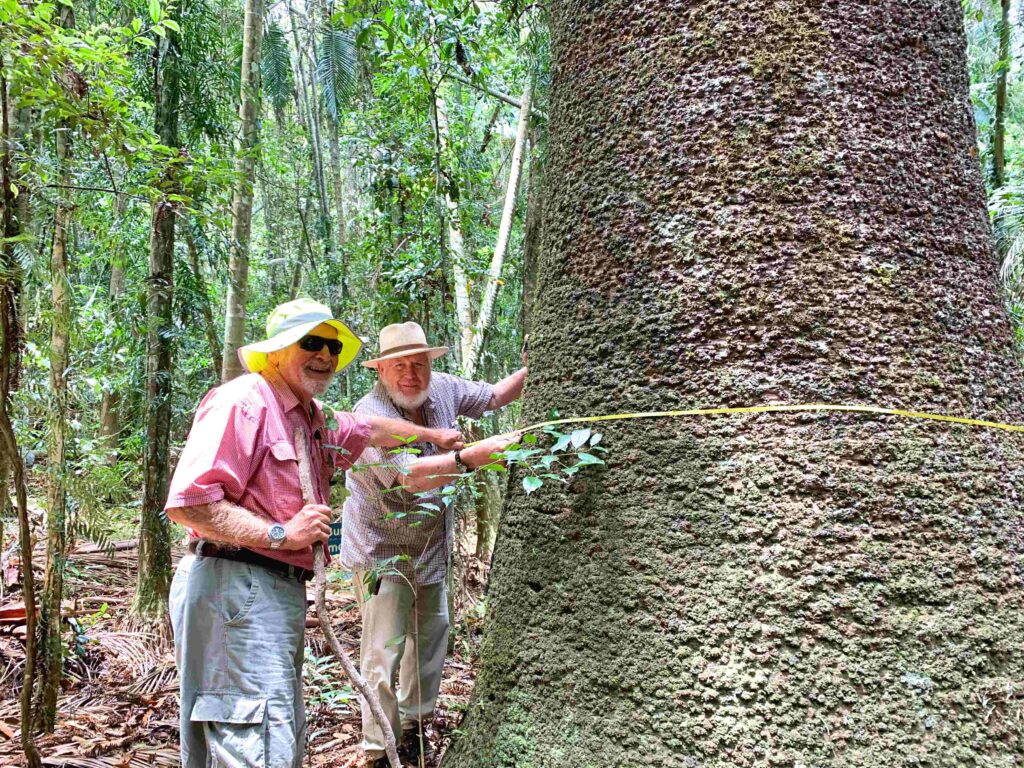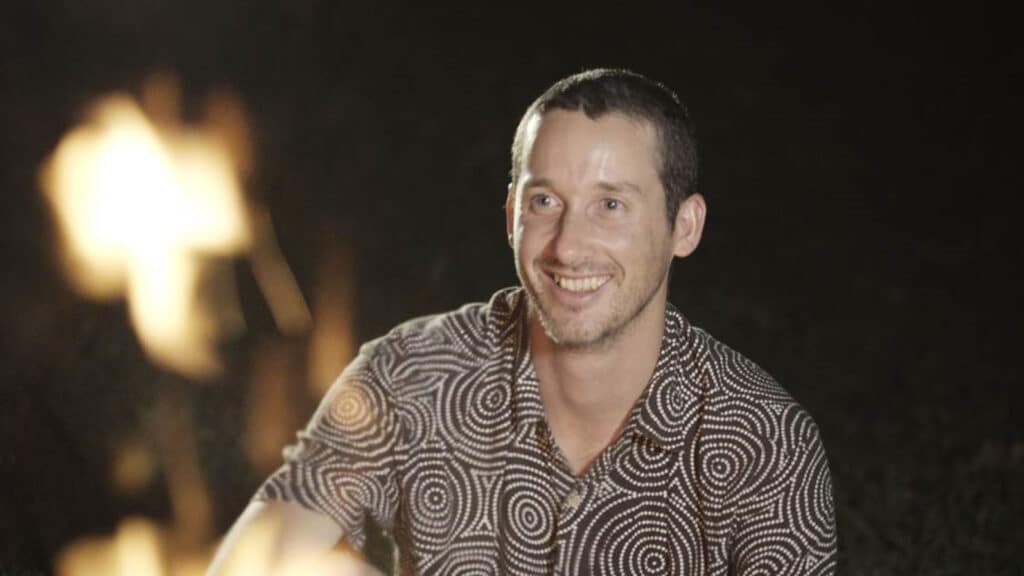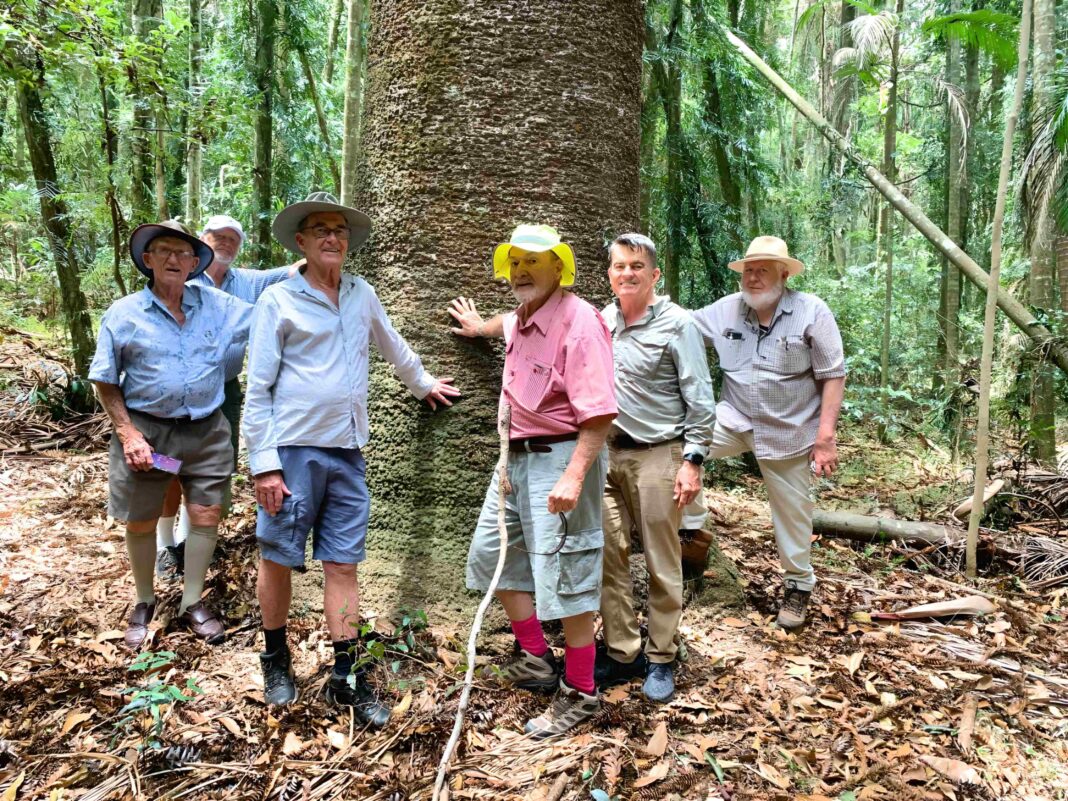A group of adventurous forestry-timber types inspecting incredible stands of re-generated hardwoods in the hinterland above Queensland’s Sunshine Coast – in particular the tall Eucalyptus pilularis – were happily ‘side-tracked’ by former log cutter Ron Sutton.
“Eureka! There it is down in that gully.”
Ron was pointing to a massive 35-metre bunya pine, a lone softwood sentinel towering over a re-generated forest thick with blackbutt trees. Age around 600 years; girth 5.2 metres.
“I joined the forest inspection with one mission,” Ron said. “That was to seek out and stand a second time beneath a tree I first ‘discovered’ in 1967. I doubt I will ever see it again.”
So, how did this Araucaria bidwillii get in that gully, far away from its normal habitat in the Bunya Mountains in Queensland’s South Burnett region, 100 km northwest of Mapleton?
Also known as the “monkey puzzle” tree, the puzzle was solved.

For thousands of years, Aboriginal people on the east coast of Australia have gathered to celebrate the harvest of the spikey bunya tree cones that can weigh up to 10 kg. They contain dozens of nutritious kernels, or nuts, that are high in protein and are similar in taste to chestnuts.
A scouting party of Aborigines most likely brought some of these bunya nuts (or seeds) down to the Mapleton hinterland about 700 years ago in a process of cultural migration. Here, the nuts and other plant foods would have been part of the ancient “smoking process”, believed to have cleansing properties and the ability to “ward off bad spirits”.
The seeds, dropped in this gully, proved the ideal moist habitat for Ron Sutton’s solitary bunya pine.
For anyone familiar with bunya pine trees, summer is associated with a distinct and interesting botanical phenomenon. Each January at the Australian Botanic Garden in Sydney’s Mount Annan, the bunyas begin to drop their cones.
If you don’t think this is a big deal, you should know that they used to be dinosaur food millions of years ago, so they have been on this earth for a very long time.
“The population of bunya pine trees across Australia appears to have come from a single source in Queensland,” says Oliver Costello, a Bundjalung man working on multiple projects for the NSW Office for Environmental Heritage.
According to Costello, there’s a significant body of lore surrounding the nuts contained in the bunya pine’s cones.
“Bunya trees fruit in the summertime, and that’s when clans from remote areas would travel to southern Queensland for ceremonies,” he says.
The abundance of the seed brought massive gatherings where people would talk folklore and indulge in feasts and marriage ceremonies before returning to their home patch, sometimes hundreds of kilometres away.
“There’s a link between bunya seed dispersal and ceremony; they’re indicative of connectivity across landscapes and languages,” says Costello.

The Mapleton National Park in the scenic Blackall Range is a landscape created by volcanoes and sculpted by water over millions of years.
Rich basalt soils, a result of volcanic activity around 30 million years ago, support warm subtropical rainforest. Tall open forests grow on poorer quality rhyolitic soils derived from a violent volcanic period that began 235 million years ago.
On the edge of the escarpment, thundering waterfalls cascade all year round, spectacular during the summer rainfall season, then dropping to a gentle trickle in drier winter months.
Mapleton Falls, Kondalilla and Mapleton National Park and other small reserves that protect the Blackall Range’s remnant forest communities and the essential wildlife habitat and provide scenic places for nature-based recreation.
At least 107 species of birds live in the Blackall Ranges, including the Australasian figbird (Sphecotheres vieilloti), which can be seen feeding on piccabeen fruits in the rainforest.
Native animals identified for the Blackall and nearby Conondale ranges include 70 species of reptiles and 32 species of frogs.
Editor’s note: The bunya pine is a general-purpose softwood used in plywood, interior joinery, linings, mouldings, furniture and general interior construction. It is especially sought for musical instruments, particularly for guitar soundboards. Density: 530 kg/m3 at 12% moisture content; about 1.7 m3 of seasoned sawn timber per tonne.
• The God’s of Re-gen. Watch for Jim Bowden’s story on the magnificent re-generated blackbutt forests at Mapleton that are now almost identical to the forest stands that were wiped out by a massive bushfire in 1922 that raged across 75,500 ha of this hinterland. The hardwood forests today are an indelible legacy to those early foresters who worked to renovate the scorched earth and bring back the forests under daunting circumstances – and sound forest management – more than a century ago.






